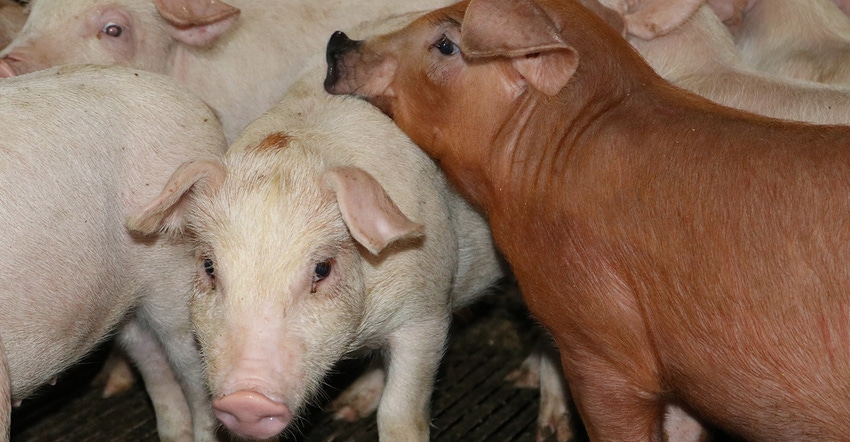Vaccination and elimination programs can be tools in controlling the sow farm production and post-weaning performance in the face of influenza.
November 25, 2020

Influenza A virus causes respiratory disease in swine and can impact sow herds. Sows infected with IAV-S can have severe to mild clinical signs, including animals off feed, lethargy, high fevers (rectal temperatures of 104 degrees F and above) and loss of pregnancy.
The use of commercial or autogenous IAV-S vaccination programs on a sow herd can mitigate the clinical signs mentioned above. Vaccine programs can vary and depend upon your herd's needs and veterinarian. Programs can include annual/semi-annual mass sow farm vaccination, post-farrowing vaccination or pre-farrowing vaccination(s).
When formulating an IAV-S vaccine program to when the goal is to decrease or prevent sick animals and reproductive losses, it's recommended to use either a commercial vaccine or a multi-valent autogenous IAV-S vaccine. Multi-valent autogenous vaccines include two or more strains of IAV-S vaccines. In an October 2019 issue of the NHF Daily newsletter I shared one approach to IAV-S with a Prime and Boost strategy. This included eight strains split into two vaccines. Utilizing an autogenous vaccine program allows for flexibility and updating/replacing IAV-S strains as genetic changes large or small are appreciated.
The immune status of the herd is important. Sows or pigs that have previous exposure to vaccination or a previous outbreak of IAV-S will have antibodies. When the new flu virus enters the host, the antibodies team up to protect the host, in this case the sow or pig. This protection results in less lung damage and pneumonia. This protection will also help shorten the course of disease and the clinical signs throughout the herd.
Vaccinations don't prevent an animal from acquiring the influenza A virus. The goal is to reduce the clinical signs and decrease the negative impact on production parameters like average daily feed intake, mortality and abortions in sows.
However, over the last 10 years, to this veterinarian, that influenza A virus that once entered a sow herd resolved in four to six weeks are now becoming endemic. The sows generally stop showing the clinical signs one to three weeks after identifying a new IAV-S introduction. The wean piglet, however, continues to show signs of IAV-S post-weaning with increased coughing, lethargy and high fevers. These pigs can have pneumonia on necropsy. If these pigs are exposed to a co-infection, especially porcine reproductive and respiratory syndrome, the post-weaning mortality is elevated.
When an influenza A virus becomes endemic, the sow herd can make adjustments to the current vaccination program to help those post-weaning pigs and farmers. One approach proven successful is to use an autogenous IAV-S vaccine that is either a mono-valent, specifically made for that flu strain and administer that vaccine to sows four and seven weeks pre-farrowing. The limitations of this approach are that it takes 12 or more weeks to obtain an autogenous vaccine specifically made for a virus or herd.
In the last two years I have been successful in using a multi-valent autogenous IAV-S vaccine with at least one of the included influenza strains having 97% or greater homology to the IAV-S of concern. The vaccine is administered at four and seven weeks pre-farrowing. If there were a commercial vaccine with similar homology to the IAV-S in need of elimination, I would hypothesize with this program it would also be effective.
In addition to the vaccination of sows pre-farrowing, once the vaccinated sows start to farrow, piglets cannot be held within the farrowing house or holding nursery post-weaning. Piglets at weaning cannot be collected as fallbacks and held for additional time. Wean sows should not be used as nurse sows or replacement sows. This will be for a period of seven to 12 weeks.
To determine if the IAV-S elimination program has been successful, 10 nasal swabs from 50 due-to-wean piglets are collected for four weeks in a row. If all samples are polymerase chain reaction-negative for IAV-S, the herd is declared to have eliminated IAV-S.
If pre-farrowing vaccines for IAV-S are not part of the preventative vaccine program, the autogenous vaccines pre-farrowing are discontinued.
The IAV-S vaccine programs to reduce mortality and reproductive losses and the influenza A elimination programs won't prevent future influenza introductions. However, they can be a tool in controlling the sow farm production and post-weaning performance in the face of influenza.
Source: Dyneah M Classen, who is solely responsible for the information provided, and wholly owns the information. Informa Business Media and all its subsidiaries are not responsible for any of the content contained in this information asset. The opinions of this writer are not necessarily those of Farm Progress/Informa.
You May Also Like



